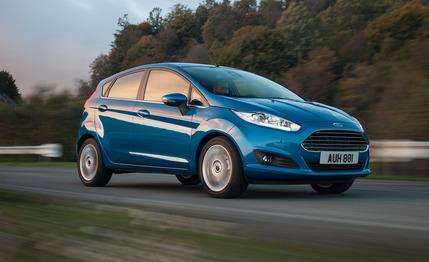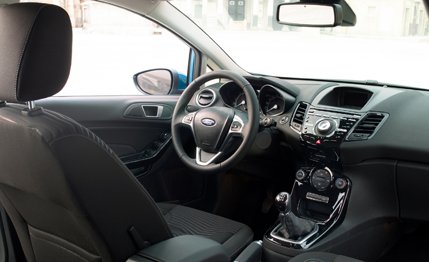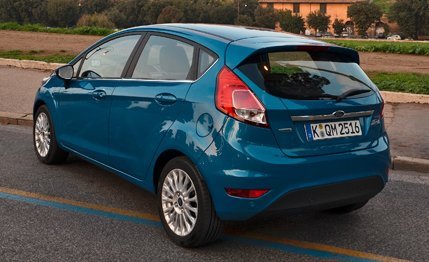
 Prototype Drive
Prototype Drive
When last we visited with Ford’s tiny 1.0-liter turbocharged three-cylinder, the EcoBoost engine was installed in a European-market Focus hatchback. Impressively smooth, we found during our testing that the little mill was nevertheless overburdened by a 2971-pound curb weight and was unable to break the 10-second barrier in the 0-to-60 run.
What a difference 450 pounds makes. That’s the claimed spread between the 1.0-liter Fiesta and the 1.0-liter Focus, and although the smaller car is no scorcher—we predict a 0-to-60 run of 9.8 seconds—the engine clearly feels freer to flex its 123 hp and 148 lb-ft of torque. It’s much more tractable, with good low-end muscle. It still needs to be caned to step away with real verve, but in the canyons surrounding Los Angeles, we found a quick downshift had the Fiesta pulling up the steep grades, well, not smartly, but like a real car. When stressed, the three’s aural signature goes a bit grumbly, but it otherwise sounds okay. Anyone who wants more grunt or more raucous acoustics will be encouraged to step up to the spicy 197-hp, five-door Fiesta ST, which will go on sale in the second half of next year, around the same time as this 1.0-liter model.


As we’ve detailed previously, the 1.0-liter has a lot of tricks up its sleeve. Atop the iron block sits a cylinder head with an integrated exhaust manifold. The tiny turbo spins at a maximum of 248,000 rpm and teams with direct injection and variable valve timing to help the three make the most of its meager 999-cc displacement. The inherent imbalance of a three-cylinder engine—it results in undesirable shaking and a rough feel—is countered by specifically weighting the flywheel and pulley; this avoids using an efficiency-degrading balance shaft. A timing belt that Ford says is submerged in oil reduces noise, too, and is claimed to be maintenance-free for life. A variable-displacement oil pump reduces friction by apportioning just the right amount of lubrication, and a split cooling system for the block and head allows the engine to get up to temperature more quickly, improving efficiency and heating up the cabin faster. In the Fiesta, the EcoBoost three will serve as an optional upgrade from the naturally aspirated 120-hp, 1.6-liter four with 112 lb-ft of torque that will carry over as the base engine. The three-banger will be available in both the hatchback and sedan.
We drove a European-spec five-door—they’ll get the 1.0-liter Fiesta before we will. Features on the cars we drove that won’t make it here include an engine stop-start system, standard summer rubber, and adjustable-height headlamps, but our Fiesta will otherwise be nearly identical. Full details on the refreshed 2014 Fiesta are available here and include interior material upgrades that keep it feeling more upscale than anything else in its class, as well as the availability of MyFord Touch.
Dynamically, the 1.0-liter 2014 Fiesta feels the same as previous models we’ve tested, which means a solid structure, a willing chassis, and weighty steering, although it has less road feel from the helm than we’d like. As in a comparison test conducted just after its initial launch, the Fiesta falls somewhat short of the Honda Fit and Mazda 2 in overall enjoyment, but it remains a decent-driving and well-kitted subcompact.


The only transmission available at launch will be a five-speed manual that's neither great nor terrible; shifts feel slightly ropy and vague, but it’s accurate enough. We asked whether the six-speed Powershift dual-clutch automatic bolts up to this engine and were given an affirmative answer. Ford reps didn’t seem particularly enthused about offering that gearbox here, though, so the 1.0-liter could remain a manual-only proposition for some time. Fuel economy is pegged at “more than 40 mpg” on the highway, but that’s the only number available for now. The company does say the three-cylinder Fiesta will be more efficient than any other conventionally powered U.S.-market car. The manual-transmission Chevrolet Cruze Eco currently has the honor on the freeway, at 42 mpg, and the highest combined figure is owned by the Scion iQ at 37. The three-cylinder Focus performed poorly in our hands—we saw 27 mpg—so we’re interested to see if the Fiesta can deliver something near the promised efficiency in real-world conditions.
Given that the car’s U.S. on-sale date is so far off, pricing is unavailable, but we expect the 2014 Fiesta to basically hold the line and for the EcoBoost engine to cost about a grand extra. That’s a decent chunk of a sub-$20,000 sticker, but takers can point to their cars as rolling proof of what losing 450 pounds can do.